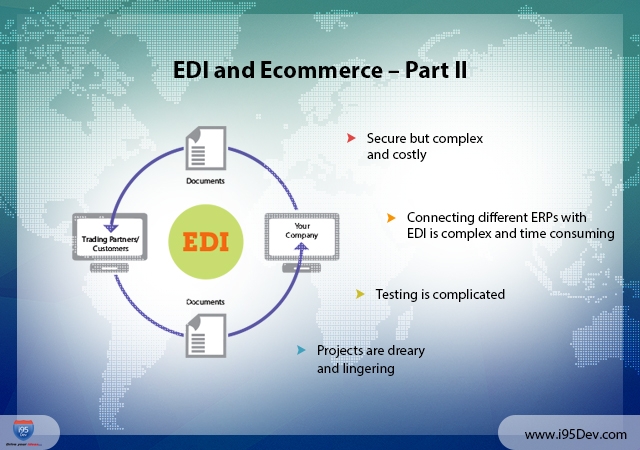Our first blog spoke volumes on the benefits of EDI integration. Now, we’ll complete the two-part series by outlining how e-commerce integrates with EDI and explain the challenges of integration.
As explained in the previous blog, EDI can help make businesses more accessible and user friendly to clients and customers. While it is well entrenched in many larger businesses, it is also being adopted by smaller businesses to increase their ability to attract trading partners, who prefer a fast and efficient way to exchange information. Implementing EDI within the Internet environment helps reduce errors in purchase ordering and therefore improves cost effectiveness. It also allows businesses to trade with larger enterprises that require EDI.
The lesser known side of the story is that the implementation of the EDI infrastructure will cost a lot of time, money and labor (e.g. training and integration). EDI usually does not make sense for only one partnership, unless that partnership represents a very large incremental increase in revenue. Failing that, it is usually prudent to have some more customers, suppliers, manufacturers and distributors using the same standard.
Secure but complex and costly
VAN is a fundamental concept on EDI in order to support asynchronous communication; otherwise, all partners had to be connected all the time to all other partners. A VAN works more or less like an Internet ISP as far as email is concerned with one major difference: a VAN is more expensive than an ISP. It usually requires the X.400 protocol instead of the simpler and cheaper Internet e-mail and connects to its customers via X.25 (not Internet TCP/IP). A VAN also provides some “added value” such as checking the message header and format and offering security, logging, archiving and auditing services. E-mail is asynchronous but famously unreliable. The challenge here is how to provide all those VAN services on top of the Internet without requiring too much change to what is already available.
Connecting different ERPs with EDI is complex and time consuming
ERP integration poses a significant challenge for EDI adoption in general, and small- to medium-size businesses in particular. The “ERP” term used here includes all kind of management software to process the kind of documents sent and received by the EDI software. What makes ERP integration important is because literally all companies with EDI, or those planning to invest in it, have an ERP. Otherwise it makes little sense to use EDI because they can have access to none of the advantages and benefits of using EDI.
While there are standards for message formats and communication protocols, there are still no standards for ERPs, which means they vary greatly in features and interfaces. Thus, trying to make two or more ERP systems communicate via EDI infrastructure is a complex job. With different ERPs for different trading partners – along with different languages and different tax rules – such projects are highly complicated and expensive. Instead, if partners could access the same ERP, connected to an e-commerce platform, but with different logins, it will remove all such complexities. The only difference is that EDI integration would have made the entire system automated. When faced with the high cost of EDI integration, managers must decide whether such automation is truly worth the cost when, for example, an e-commerce integration can accomplish the same end result but for less cost.
Testing is complicated
It is often difficult to predict how long testing is going to take when installing EDI. In certain cases, it involves dozens of different companies who receive the EDI, rendering the complexity enormous. Hence, if an ERP e-commerce integration solution can solve the purpose with different trading partners using the ERP, then why use EDI? Intelligent business houses these days are sincerely asking themselves this question before jumping into the ocean named EDI.
Projects are dreary and lingering
EDI projects being complex are normally long running. In certain scenarios, given the fact that the time-consuming nature of EDI testing, the number of trading companies involved and their changing internal architecture, such projects face enormous challenges in fixing. At the very least, even a mid-size EDI project requires six months of work, with lots of potential for delays and cost overruns. On the other hand, an e-commerce ERP integration is a much simpler plug-and-play solution, with no headache, no big intricacy, no need to wait for months – a simple solution to all the labyrinthine problems.




